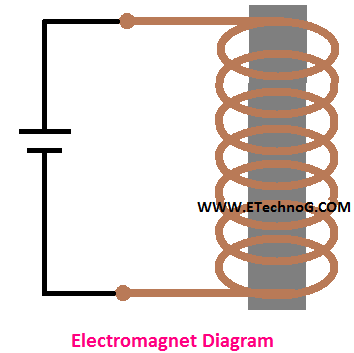Electromagnet VS Electromagnetic Induction
Electromagnet or Electromagnetism and Electromagnetic Induction hearing almost the same but it's not true. There is a big difference and different phenomenon you should know. In the field of electrical engineering, the role of electromagnetism and electromagnetic induction is incomparable. The applications of them are everywhere. From an electronic toy to large electrical machines such as motors, transformer everywhere electromagnetism and electromagnetic induction are used.
Electromagnet or Electromagnetism Principle
Electromagnetism is the phenomenon of producing a magnetic field in a coil when an electric current following through it. When the coil produces the magnetic field and acts as a magnet then it is called an electromagnet. So electromagnet is nothing but a coil wound on a magnetic core made of ferromagnetic material(soft iron).
 |
| electromagnet diagram |
The electromagnet is not permanent, the magnetic field appears when an electric current flowing through it and it will disappear when the electric supply disconnected. Not only coil, in fact, when an electric current flowing through a wire or conductor it creates a magnetic field but electromagnets are designed as a coil to concentrate the all magnetic flux at the center to create a strong magnetic field.
The strength of the magnetic field produced by an electromagnetic depends upon the turns of the coil, nature of the input power supply. The poles of the electromagnet also depends upon the applied power supply. If the polarity of the power supply changed, the poles of electromagnet also be changed. For example, if we reverse the polarity of the power supply, the poles will be reversed.
Electromagnetic Induction Principle
When a conductor is placed in a changing magnetic field, an electromotive force or EMF is produced across the conductor. This phenomenon is known as Electromagnetic Induction. When that conductor is closed circuited, an electric current starts flowing through that conductor due to the EMF across the conductor. EMF is nothing but an electric pressure or voltage. Generally, a coil is used instead of a single conductor to create more EMF for electromagnetic induction applications.
One thing remember that electromagnetic induction not only happens when a conductor or coil placed into changing magnetic field also happens when a moving coil is placed inside a constant magnetic field. This happens because there also the coil experiences a changing magnetic field.
Small PMDC(permanent magnet direct current) generators are work on the principle of electromagnetic induction where a moving coil is placed inside a constant magnetic field(created by a permanent magnet).
Electrical Transformer works on the principle of electromagnetic induction where a coil placed near a changing magnetic field created by another coil. The changing magnetic field is created in the primary coil by apply a alternating power supply. If we apply a constant DC power supply to the coil, the produced magnetic field also be constant and there will be no electromagnetic induction. For this reason a transformer cannot work with DC supply.
Read Also: How EMF is induced? Types of induced EMF.
Electromagnetism VS Electromagnetic Induction
1. Electromagnetism is the phenomenon where the flow of electric current causes to create the magnetic field. On the other hand, electromagnetic induction is the phenomenon where a magnetic field causes to creates the flow of electric current.
2. Electromagnetism consumes electricity whereas electromagnetic induction helps to generate electricity.
3. Electromagnetism only involved in energy conversion means it converts electrical energy into magnetic energy, mechanical energy. On the other hand, electromagnetic induction involved in energy conversion and energy transfer. An induction motor is the example of energy conversion by electromagnetic induction whereas wireless charging is the example of energy transfer by electromagnetic induction.
4. Electromagnetism loses low electrical power because here only conduction happens. On the other hand, electromagnetic induction loses more electrical power as the induction process happens.
5. Electromagnetic induction is not involved in electromagnetism but electromagnetism must be involved in electromagnetic induction except for permanent magnet machines.
Electromagnet Use and Applications
Electromagnets have a wide range of applications from electronic devices to electrical devices such as actuators, loudspeakers, solenoids, relays, electric motors, electric generators, transformers.
Electromagnets are widely used in automation systems also such as automatic water dispensers, Door lock unlocks systems, etc.
Electromagnetic Induction Applications
The important applications of electromagnetic induction are Electrical Transformers, Induction Motors, Electric Generators, Induction cookers, wireless charging, magnetic flow meters, etc.
Read Also:
Electromagnet VS Electromagnetic Induction
 Reviewed by Author
on
May 26, 2021
Rating:
Reviewed by Author
on
May 26, 2021
Rating:
 Reviewed by Author
on
May 26, 2021
Rating:
Reviewed by Author
on
May 26, 2021
Rating:

